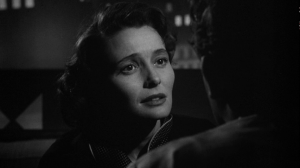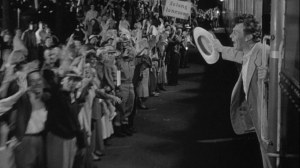The Best Shots of A Face in the Crowd
A Face in the Crowd asks Andy Griffith to embody Larry “Lonesome” Rhodes, a sort of barnstorming hick that rouses the nation over the airwaves (first by radio, then by TV) with his lack of pretense. But it’s hard to know what’s more condescendingly offensive: that his schtick works as it does, with all these fawning reaction shots of “aw-shucks” Americans in their old-fashioned living rooms and kitchens, smitten with a voice that finally speaks for them; or that Lonesome finally succumbs to corruption, like all star-is-born types inevitably do (or at least the males, those power-starved horndogs!). Worse, in order to fell him, the movie resorts to the cheap trick of having him learn to despise the masses who love him, and spout his disdain just when he thinks they aren’t listening. One would think he, of all people, would know how they hang onto every word.
If Lonesome’s story is supposed to be prescient of some latter-day reactionary American TV blabmeister like Glenn Beck, the ending’s all wrong. He has to go down not in audience outrage, but with apathy and gunfire: the way Paddy Chayefsky would predict it, two decades later. Though to be fair, A Face in the Crowd doesn’t pretend to show the end of Lonesome’s days, only preaching its eventuality in a capping, pre-Networkian monologue by Walter Matthau. The movie instead cuts the story off halfway, as though director Elia Kazan decided that A Streetcar Named Desire, one of his earlier collaborations with DP Harry Stradling Sr, should have just ended with Marlon Brando screaming “STELLAAAA!” into the sweltering night. A Face in the Crowd ends with such a scene, except Griffith doesn’t have half of Brando’s power, which is less a mark on his talent than on the odds stacked against his role. Structurally, the role demands that we fall for Lonesome in his rise to power, before growing horrified at what he becomes. So while it’s to Griffith’s credit that he keeps Lonesome within a believably narrow range of lock-jawed bluster throughout this arc, both actor and DP have to modulate our early allegiance to Lonesome with his eventual arc in mind. In this way, the movie differs from the demands on Stradling for Funny Girl, a later star-is-born flick which didn’t need him to do anything but keep us headily in love with Barbra Streisand.
 A far more intractable challenge for Griffith, too, is that the film mostly sees Lonesome through the perspective of Marcia Jeffries (Patricia Neal), the radio announcer who first discovers him in a county jail. As Marcia, Neal spends much of the movie watching Lonesome—as a manager, an audience member, a mesmerized woman, a spurned lover, a tormented creator—which means that we count every casual bedmate and betrayal against him, far before he reaches the level of ego-stoked monstrosity. “A Face in the Crowd”, her radio show that gives the movie its title, also applies more to her than it does to him—not just because Stradling lights Neal’s face with such fierce luminosity, even within shots where she takes a backseat to Griffith’s hamming; but also because she’s the one who remains as anonymous as the title implies, both to the masses and to Lonesome himself. “Don’t hurt me,” she implores to him in a very touching scene, but we know he will, even to the end, when she has to admit to having betrayed him because he still can’t see that it was her who did it.
A far more intractable challenge for Griffith, too, is that the film mostly sees Lonesome through the perspective of Marcia Jeffries (Patricia Neal), the radio announcer who first discovers him in a county jail. As Marcia, Neal spends much of the movie watching Lonesome—as a manager, an audience member, a mesmerized woman, a spurned lover, a tormented creator—which means that we count every casual bedmate and betrayal against him, far before he reaches the level of ego-stoked monstrosity. “A Face in the Crowd”, her radio show that gives the movie its title, also applies more to her than it does to him—not just because Stradling lights Neal’s face with such fierce luminosity, even within shots where she takes a backseat to Griffith’s hamming; but also because she’s the one who remains as anonymous as the title implies, both to the masses and to Lonesome himself. “Don’t hurt me,” she implores to him in a very touching scene, but we know he will, even to the end, when she has to admit to having betrayed him because he still can’t see that it was her who did it.
Ironically, while I found much of A Face in the Crowd far too didactic to enjoy, the shot I love most from it happens to encapsulate its plot trajectory, though in a much subtler form. (You can find two frames from it at the top of this post.) In a half-minute take that seems to go on forever, Lonesome waves to a long entourage of fans from aboard a train bound to his new TV show in Tennessee. We see the occasional placard announcing their pride and good luck, but the last one we pass by reads “So long lonesome” (see topmost frame). Of course the fans are referring to his stage name “Lonesome”, but for once the irony of the original adjective emerges: the take extends beyond the furthest edge of the platform, and Lonesome is plunged into darkness, momentarily without an audience to cater to, and he looks ahead past the camera into an uncertain future.
A Face in the Crowd | 1957 | USA | Director: Elia Kazan | Screenplay: Budd Schulberg | Cast: Andy Griffith, Patricia Neal, Anthony Franciosa, Walter Matthau, Lee Remick


![A Face in the Crowd: [Silence]](http://www.againstthehype.com/wp-content/uploads/2010/08/vlcsnap-2010-08-27-17h00m33s168-300x168.png)

ah great minds think alike. that was the exact shot i chose for this… until i started writing and got hung up on other. fine writeup here.
1